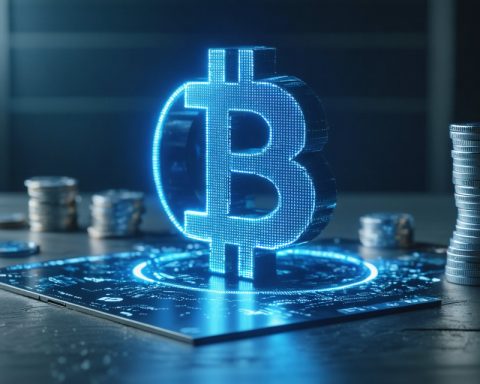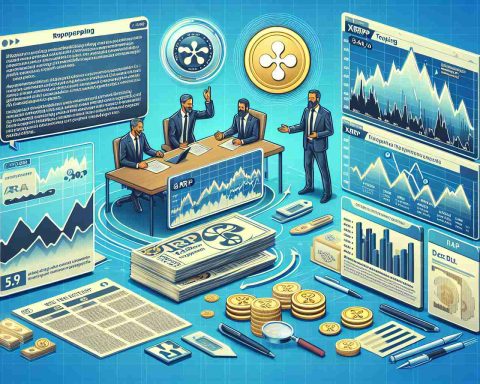The Future of Cryptocurrency: XRP’s Role
Ripple’s XRP has been making headlines with a staggering 433% growth since November, igniting debates about its impact on the future of cryptocurrency. Though analysts project that XRP’s rise may challenge Ethereum’s market value, currently at $3,203, the broader implications of this trend go beyond mere price comparisons.
Environmental Concerns and Technological Evolution
While XRP’s less energy-intensive consensus algorithm positions it as an environmentally friendlier alternative to Bitcoin’s proof-of-work system, the surge in cryptocurrency activities globally has led to increased scrutiny over ecological consequences. As new investors flock to the crypto space, the demand for energy-intensive mining operations rises, often at the cost of increased carbon emissions. Balancing this growth with sustainable energy practices presents a critical challenge for the future.
Reimagining Financial Systems
XRP isn’t just a token; it represents potential shifts in financial innovation. Its possible ascendancy above Ethereum signifies an evolving landscape where transactions could become faster and less costly, especially in areas of cross-border payments. This capability could democratize finance, making financial services more accessible to underserved populations and reshaping conventional banking paradigms.
Regulatory Dynamics and Challenges
Regulatory landscape shifts, particularly in the U.S., hint at potential advantages for XRP. With speculation about the resignation of SEC Chair Gary Gensler and possible settlement talks with Ripple, regulatory relief could invite additional investor trust and participation. Nonetheless, this environment requires clarity and robust frameworks to ensure widespread adoption.
The Human Element
The excitement surrounding XRP’s climb also entails market risks, raising questions about financial volatility and inclusivity. As attention shifts from Bitcoin to XRP, the potential economic benefits could be offset by the dangers of speculation, especially for inexperienced investors. Ensuring equitable opportunities while mitigating risks remains a vital consideration.
In an interconnected global economy and tech-driven society, XRP’s journey underscores the imperative of aligning innovation with environmental sustainability and economic welfare. As XRP continues to rise, it propels broader discussions on how cryptos can transform without sacrificing ecological and financial integrity.
XRP’s Impact: Bridging Innovation and Sustainability
As the cryptocurrency market evolves, Ripple’s XRP stands at the forefront with its impressive growth trend. Beyond its potential to reshape financial systems and challenge leading cryptocurrencies like Ethereum, XRP offers a compelling narrative about technology and sustainability. This mix of innovation and environmental consciousness is pivotal in understanding the broader implications for humanity’s future.
Cryptocurrency and the Environment
One of the significant environmental considerations within the cryptocurrency sphere is energy consumption. Traditional cryptocurrencies like Bitcoin require massive amounts of energy due to their proof-of-work consensus algorithm, which has a substantial carbon footprint. In contrast, XRP employs a consensus algorithm that is markedly less energy-intensive, presenting a more environmentally friendly alternative. As global environmental consciousness grows, XRP’s lower energy requirement could set a precedent for sustainable cryptocurrency development.
By focusing on energy-efficient technologies, ripple effects (pun intended) can transform how digital assets interact with the environment. An industry-leading move towards sustainable practices will not only reduce carbon emissions but also encourage other sectors to adopt greener solutions, nudging humanity toward a more sustainable future.
The Human and Economic Impact
XRP’s technological capabilities promise more than just environmental benefits. Its potential ascent to challenge Ethereum might lead to faster and more cost-effective transactions, especially in cross-border payments. This innovation could dismantle financial barriers, making banking and financial services more accessible to underserved and unbanked populations across the globe. By democratizing finance, XRP could contribute to greater economic inclusivity, potentially lifting communities out of poverty and advancing global economic equity.
This financial democratization is particularly significant in developing regions, where traditional banking infrastructure is limited or absent. Access to efficient financial services can empower individuals, fostering entrepreneurship and economic growth. Consequently, as XRP enhances global financial systems, it bears the promise of connecting the disconnected, thus shaping the socio-economic fabric of future societies.
Future Preparedness: Regulatory and Market Considerations
The XRP journey also highlights essential considerations in the regulatory and market landscapes. As anticipation builds around possible regulatory shifts and resolutions with the SEC, the future of XRP and cryptocurrencies, in general, could see increased legitimacy and investor interest. Clear, robust regulatory frameworks are imperative to secure investor confidence and promote widespread adoption while mitigating risks associated with market volatility and speculation.
Ensuring that the transformation brought by cryptocurrencies aligns with equitable opportunities and inclusivity will be crucial. As we navigate through this digital financial revolution, safeguarding new investors and preventing financial exclusion will contribute to a balanced and resilient economic ecosystem.
Conclusion
XRP’s advancements are more than just economic phenomena; they have significant environmental, human, and regulatory implications. The cryptocurrency embodies the synergy between innovative financial solutions and sustainability, presenting a blueprint for future technological advancements. As we forge a path forward, aligning cryptocurrency growth with ecological and economic considerations will be vital in ensuring that this digital evolution benefits humanity as a whole, fostering a future that is both prosperous and sustainable.
Is XRP Leading the Future of Cryptocurrency? New Insights and Implications
Key Features and Innovations of XRP
Ripple’s XRP is gaining attention not only for its impressive market surge but also for its unique technological features. Unlike Bitcoin’s energy-consuming proof-of-work system, XRP employs a consensus algorithm that minimizes environmental impact. This aspect makes XRP a compelling choice for eco-conscious investors looking to enter the cryptocurrency market.
Comparative Analysis: XRP vs. Ethereum
While XRP is often compared to Bitcoin and Ethereum, its potential to exceed Ethereum in market value highlights its unique advantages. XRP’s faster transaction speeds and lower costs offer significant benefits, particularly for international financial transactions. This makes it a potential game-changer in the realm of cross-border payments, challenging Ethereum’s current position in the crypto hierarchy.
Pros and Cons of XRP Adoption
Pros:
– Environmental Sustainability: XRP’s consensus mechanism is less energy-intensive, reducing its ecological footprint.
– Transaction Speed and Cost: Offers rapid processing and minimal transaction fees, facilitating efficient international transfers.
Cons:
– Regulatory Uncertainty: Ongoing legal battles with regulatory bodies such as the SEC could impact investor confidence and market stability.
– Market Volatility: The rapid price increase makes XRP susceptible to market speculation, posing risks to inexperienced investors.
Predictions and Market Trends
Market analysts predict a continued interest in XRP, driven by its potential regulatory advancements and technological advantages. Given the global focus on sustainable finance, XRP’s environmentally friendly model may gain further traction. Additionally, if regulatory landscapes become more favorable, XRP could attract more institutional investors, propelling its market value even further.
Specified Use Cases and Real-World Applications
XRP’s use cases extend beyond simple transactions. It is increasingly being deployed in various sectors for its ability to streamline cross-border payments and reduce currency exchange costs. Financial institutions and banking systems are exploring its adoption to enhance efficiency and inclusivity, which could revolutionize traditional banking methods.
Security Aspects
XRP’s security framework is designed to withstand common cyber threats, although the broader cryptocurrency market remains vulnerable to hacking attacks and fraud. Continuous advancements in security protocols are crucial to protect both assets and user data, ensuring a reliable platform for global transactions.
Future Insights and Sustainability Efforts
With the cryptocurrency market under scrutiny for its environmental impact, XRP’s model is a step towards sustainable digital finance. As more investors and developers prioritize eco-friendly solutions, XRP could lead the charge in transforming how digital currencies operate in harmony with the planet’s ecological values.
Conclusion: Charting a Path Forward
As XRP navigates the complexities of market dynamics, regulatory challenges, and environmental considerations, its trajectory offers valuable insights into the future of cryptocurrency. Balancing innovation with sustainability and regulatory compliance will be pivotal in defining XRP’s role in the evolving financial landscape.
For more information on XRP and its potential impact, visit Ripple.













